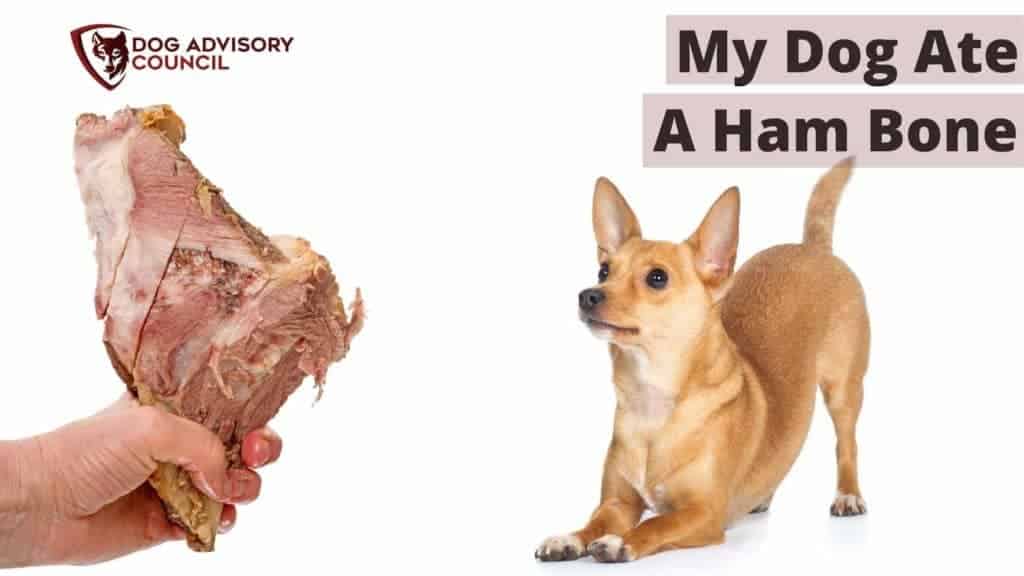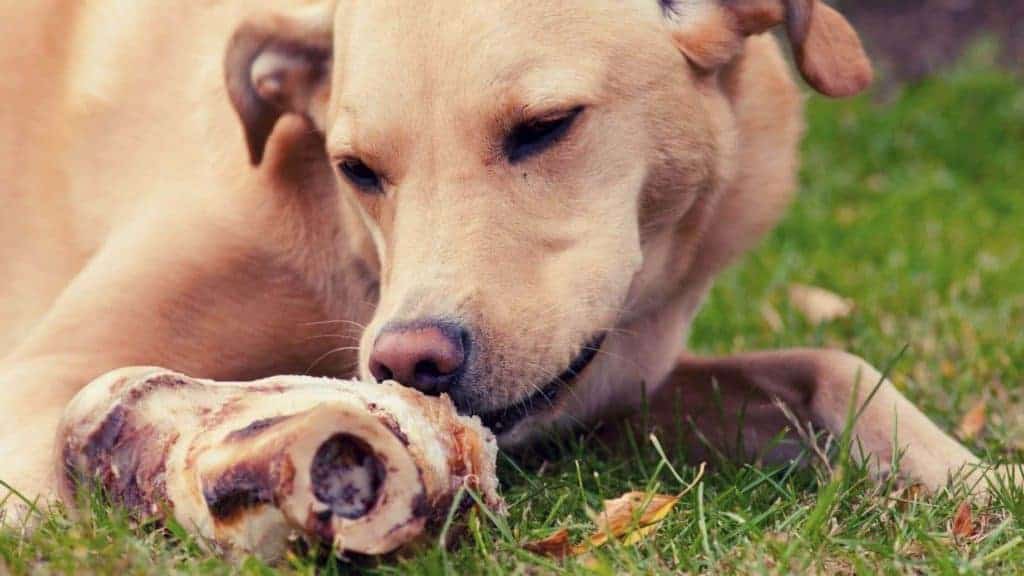
Your intention to bring your dog into the celebrations by gnawing on the ham bone may have gone awry when you notice that they ate the bone. What do you do? Read on to find out.
Eating a ham bone is always a reason for concern, as a ham bone is at a high risk of splintering and creating a sharp edge as it moves through your dog’s intestines. This can leave them at a high risk of internal bleeding and obstruction in the intestines. It can also cause an infection in the abdomen called peritonitis. Even if you know the signs and symptoms, many don’t show them until they are already very sick. They will require emergency surgery, and this has a 50-70% chance of survival.
Can dogs have ham bones?
It’s never a good idea to allow your dog to have or eat ham bones. While you can relatively safely give your dog a large bone and then watch him for every second, even this is not recommended. As far as experts are concerned, dogs should not have ham bones ever since they are dangerous. Still, want to give him one anyway? We’ve covered that at the end to make it as safe as possible.
Unlimited claims, No credit checks, No upper age limit & Multiple pet discounts
Compare the best rates on pet insurance
Can a ham bone make a dog sick?
In most cases, a ham bone will almost certainly make your dog sick. The chances of it simply passing through with no damage whatsoever are rare. That’s part of why ham bones are seen as severe complications! Some of the sickness-related problems can include:
- Infection
- Indigestion
- Diarrhea/obstruction
Infection
This could be an infection in their mouth, throat, abdomen, intestines, etc. Anywhere the bone goes, it can cause cuts, which can cause inflammation, and then they can get infected. Since they are internal, this can be hard to spot and can lead to a life-threatening condition called peritonitis. We’ll get more into that later.
Indigestion
The ham bone can easily cause indigestion as your dog struggles to break it down, and this can lead to all sorts of problems like lack of appetite, diarrhea, flatulence, and just general discomfort.
Diarrhea/obstruction
If there is an obstruction from the bone getting jammed in the stomach or intestines as it weaves its way through (even assuming it hasn’t splintered), that can lead to backup and a severe problem that will most likely need surgery to fix it.
What can happen if a dog eats a bone?
As mentioned earlier, eating a hambone is always a serious complication, no matter how “good” it may turn out to be. As far as the actual chain of events is concerned, the main “checkpoints” can all be cause for concern.
- Chewing/swallowing
- Digesting
- Excreting
Chewing/swallowing
As your dog chews the bone and swallows it, the chewing can splinter the bone, leading to shards going down the throat and mouth cuts. Swallowing those pointed shards can lead to cuts in the throat as well.
Digesting
When the bone makes it down to the stomach, it needs to break down and digest. It starts in the stomach and travels through the intestines. The bone will back up this digestion since bone takes a long time to break down. One of the biggest problems is the sharp pieces.
They can create rips in the stomach as well as throughout the intestinal system. Since this is twisty and turney by design, the shards will rotate and rip. It can also cause serious perforations leading to internal bleeding and even get lodged and create an obstruction.
Excreting
Even if they digest the bone safely and get it down to the colon, excreting it can be challenging! It will be much harder to pass and will cause a blockage as far as the other parts of his stomach that need to be excreted (aka the other food).
What is the biggest concern?
For most professionals, the biggest concern is going to be the possibility of Peritonitis. This is what we introduced briefly above. This is when cuts in the stomach and abdomen cause inflammation, leading to cavities that quickly become infected. Since it’s all internal and can be very challenging to diagnose early, this often is only diagnosed once the infection is raging.
The only way to intervene at this point would be surgery, followed by a strong and long-term dose of antibiotics to help fight it. However, many dogs don’t survive the surgery. This complication is prevalent with ham bones, so it’s essential to take it seriously.

Symptoms to look for when a dog eats a bone
If you are reading this after the fact and your dog has eaten a ham bone, you’ll need to start doing “damage control.” This mostly means extreme vigilance. The first 24 hours are crucial, so make sure you watch him very closely for any possible complications. Those problem symptoms include:
- A bleeding mouth
- Lots of drinking
- Discomfort in the mouth or with the tongue
- Vomiting
- Dar-colored poops/lack of poop
- Lethargy
- Lack of appetite
- General unease
If you notice any of these problems, you will want to get your dog to your vet as soon as possible. The sooner internal injuries are diagnosed, the better outlook your dog has!
Will my dog be OK after eating a ham bone?
It all depends on how much ham bone your dog ate. If you have a large dog who only has a tiny piece of ham bone, your dog has the strongest chance of being OK. However, dogs will rarely pass it without complication if it was a standard dog with a normal ham bone.
If your dog has eaten a ham bone, the safest thing you can do is to assume that he will have complications.
What should I do if my dog ate a bone?
If you notice that your dog ate a bone, familiarize yourself with the symptoms listed above, and prepare yourself to watch him carefully. If anything at all seems out of the ordinary — no matter how mild — then you immediately want to act on it. Don’t wait “just in case,” because it might be too late!
The other thing is to immediately call your vet and let them know what’s happened. They may ask some questions and offer suggestions personalized to your specific dog. If they recommend that you take them in immediately, definitely follow their advice. The only thing that waiting will do is cause more problems.
Do bones dissolve in a dog’s stomach?
Dogs can break down bones in their stomach, yes. The main concern is that dogs splinter the bones with their strong jaws, and the sharpness will continue to be a problem as they break down and pass through the system. These sharp edges are what cause a risk to your dog!
How do you tell if your dog has a bone stuck?
This mostly depends on where the bone is stuck, of course. If your dog is choking or coughing, the bone is stuck in his throat somewhere. If he is vomiting, having trouble pooping, or generally uncomfortable, there is a blockage in the digestive system somewhere. If you even suspect there is a bone stuck, take him to the vet immediately.
How fast do dogs digest bones?
The pace depends on the size ratio, but the general rule is that 24 hours is the digestion time. If your dog is still symptom-free after 24 hours, and he’s had several poops, you can assume that he is OK.
Should dogs swallow bones?
No! If you suspect that your dog will swallow dog bones, then you should take them away from your dog’s reach. Bones are always dangerous, and ham bones especially so.
How to help a sick dog who ate a ham bone
If you want to do everything within your power to care for your dog at home, feeding him a bland diet of bread and pumpkin can help! This bulky food will help absorb the shards of bone and push them harmlessly through the body. It also is a bulky food that will help ease digestion itself, making the process faster.
When to see the vet
If you notice any symptoms, a vet visit is a great idea, of course, since they can be indicators of a severe complication. However, it’s also a good idea to take your dog in to see the vet just in case. After all, you’d take your child to the emergency room if you weren’t sure of something, so consider the same quality of care for your dog, too!
The difference between raw and cooked ham bones
Above, we are assuming that you gave your dog leftover ham bones from a special meal. The cooked ham bones are much softer and prone to shattering easier, which is why they are such a risk.
If you are looking at giving your dog ham bones and set on doing it, you’ll want to stick to raw ham bones. These are stronger and are less likely to splinter as bad compared to their cooked equivalents.
In either case, you will need to prepare yourself for any possible implications and be ready to watch him like a hawk for 24 hours. At this point, you perhaps may want to ask yourself the question: is this snack worth the worry and supervision?
FAQ: Is my dog sick after eating a ham bone?
Here are some o the common questions (and solutions) that people wonder about after their dog eats a ham bone:
- My dog has diarrhea after eating a ham bone
- My dog is constipated after eating a ham bone
- My dog is vomiting ham bone fragments
My dog has diarrhea after eating a ham bone
Your dog is probably struggling with indigestion and possibly a blockage in his intestines. If the diarrhea is strained and bloody, this is especially likely. You’ll need to bring him to the vet to be sure.
My dog is constipated after eating a ham bone
If your dog cannot poop at all, even if he tries, this is another sign of a blockage after eating a ham bone. This will need a trip to the vet!
My dog is vomiting ham bone fragments
In this case, your dog could have cuts or other pain in his mouth, throat, or stomach. He’s trying to get rid of them by throwing them up. If you definitely see shards in the vomit, that means that there is more in his stomach that he can’t get up. You will want to take him to the vet!
In the end
If a dog eats a ham bone, it’s immediately a cause for concern. Ham bones splinter quickly, and their sharp edges can cut and injure your dog’s insides. It can cause infections, obstructions, cuts, and more.
Eating a ham bone is rarely risk-free, so you can expect a vet visit in the future if this is the case!
When a dog eats a ham bone, it’s all about waiting and watching. Understanding the symptoms is a great start.
Know someone who could use a refresher as the holidays approach? Consider sharing this with them!
Unlimited claims, No credit checks, No upper age limit & Multiple pet discounts
